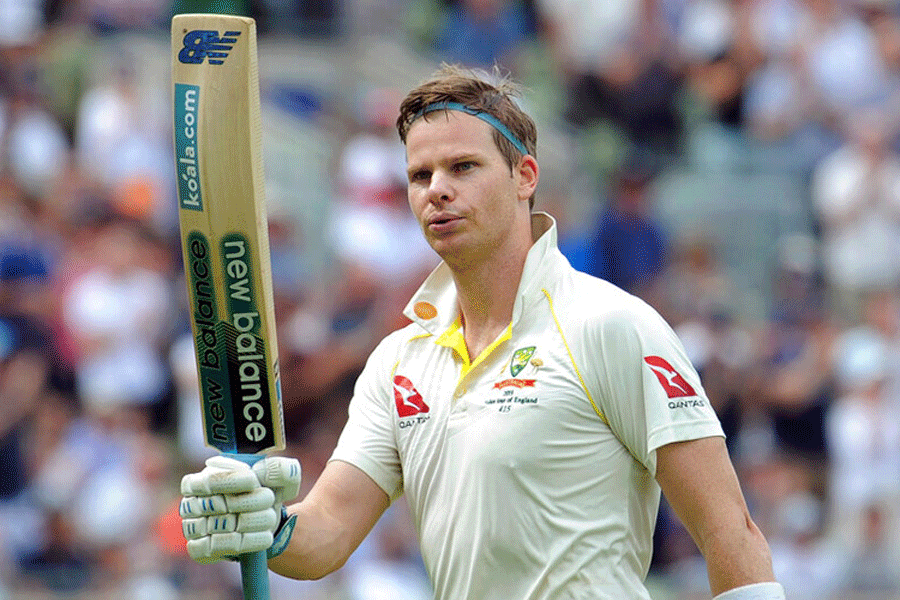With an orthodox cover drive Steve Smith, the most unorthodox of batsmen, reached his 32nd Test hundred on the second day of the Lord’s Test. It is his eighth century in England. Only Sir Donald Bradman, of all tourists, has scored more Test centuries over here.
With a shovel through midwicket and a couple of squeezes or squirts to the third-man boundary, Smith moved to 99 before reaching his landmark and celebrating with yet another change of batting gloves from his bin-bag in front of the Lord’s pavilion. And all the time he took this match, and series, in the direction of the southern hemisphere.
Even England’s most diehard supporters however would concede that Smith, personally, is hard to hate — whatever happened under his aegis during the Sandpapergate scandal. He is a magnificent obsessive; nobody else has turned an innings into a Jacques Tati mime. England are new to Bazball but for more than a decade Smith has been playing Oddball.
One or two batsmen have had equally elaborate routines before the ball was bowled, going through their ritual of superstitions. One was the batsman who scored the most runs in any championship season, Phil Mead of Hampshire, who clocked almost 3,000 in 1928. Before every single ball he tugged the peak of his cap four times, tapped his bat in the crease four times, then took four shuffling steps to assume his stance. Imagine enduring that routine when your lagging over-rate is incurring penalties.
Smith, of course, goes much further than Mead or any other mortal. Tugging his pads and the rest of his equipment, twitching and playing the ball, are simply the prelude to his theatrics.
Imagine a pianist who, having played an exquisite chord, turns to the conductor and replicates the movements of his baton. However aesthetically pleasing the stroke that Smith has played, he distracts his audience, and prevents us from fully appreciating it, leaving us instead to wonder at his mindset.
Being obsessive, Smith feels the urge immediately to inform the bowler of the type of ball that he has just bowled. If he has bowled an inswinger or a leg-cutter, Smith re-enacts the delivery with his gloved right hand. The gesture may be designed, in part, for the benefit of his batting partner, the non-striker, to keep him abreast. Largely, one suspects, Smith does it because he cannot resist his impulse.
If an ordinary human being were to stage these theatrics after the ball had been delivered, he would be accused of mickey-taking and fielders would give him heaps, but there is a childish innocence about Smith’s obsession, devoid of cunning. Perhaps it is as well that Smith now rarely bowls the leg-spin of his youth: after each delivery he might re-enact the stroke which the batsman should have played, in addition to the ball he had just delivered.
It is a relief therefore when Smith plays a shot that goes for runs. No time then for re-enactments; he has to get his skates on. Yet somehow he manages not to run between wickets like other batsmen, but like a rag-doll run wild.
He surely has to be rated now as Australia’s best batsman ever apart from Sir Donald Bradman. Ricky Ponting had one horror show against Indian spinners, Greg Chappell against West Indian fast bowlers. Smith twitches, fidgets and scores against all bowlers in Test cricket —and that is simply in hishotel room, before coming to the crease.
Exactly like Bradman, driving through the offside on the front foot is the last thing Smith wants to do in England: never, for him, the front foot planted down the pitch and a booming drive at the risk of the ball deviating off the grass first, except when batting with the tail and forced to throw the bat as he did here. Otherwise, the ball has to be full to tempt him forwards and, such is his self-control and so disciplined his game plan for every innings, that he is not to be tempted.
Smith’s bottom-handedness, just like Bradman’s, limits the aesthetics: no front elbow leading him into the cover drive and trouble. Of the 10 who have scored more Test centuries, only Sir Alastair Cook has been so unpleasing to behold as the Smith of all cricketing Smiths, and, as he averages 79 there, a lord of Lord’s too.
The Daily Telegraph in London










